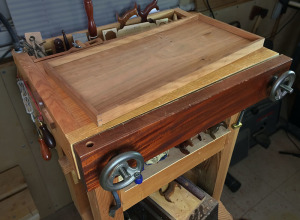RWW 190 The Joinery Bench
 I built this bench leading up to Woodworking in America in 2011. It was designed to be a solution for all those tasks that force you to bend over or stoop low to see a line or cut a joint. In the last 3+ years it has grown to be my go to work surface for just about everything after milling. It is my favorite place to work in the shop especially now that I have remodeled and I have the joinery bench in a central spot under a window. I decided to build a simple project to illustrate how well the joinery bench works not only for joinery but with the planing beam it becomes the perfect apartment or small shop workbench. As you will see in this video I now have solid experience (and footage) to back up my conclusions that this workbench is outstanding for:
I built this bench leading up to Woodworking in America in 2011. It was designed to be a solution for all those tasks that force you to bend over or stoop low to see a line or cut a joint. In the last 3+ years it has grown to be my go to work surface for just about everything after milling. It is my favorite place to work in the shop especially now that I have remodeled and I have the joinery bench in a central spot under a window. I decided to build a simple project to illustrate how well the joinery bench works not only for joinery but with the planing beam it becomes the perfect apartment or small shop workbench. As you will see in this video I now have solid experience (and footage) to back up my conclusions that this workbench is outstanding for:
- Carving
- Dovetails
- Lay out
- Tenons, dados, grooves, etc
- even sticking small mouldings
I can’t say enough about having a dedicated bench like this. Moxon vises are nice and bench on bench set ups are even nicer. But having a dedicated bench for these tasks is a game changer. If you have a spare 6 square feet in your shop, I highly recommend adding your own joinery bench. If you do, please send me some pictures, I’d love to see it and hear how it is working out for you.
For More Information on the Joinery Bench…
- Visit the Joinery Bench project page
- Or check out Hand Tool School Semester 3 where I actually build the bench and focus the whole semester on building and designing workbenches.


